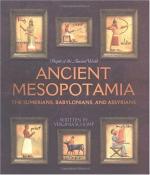|
This section contains 445 words (approx. 2 pages at 300 words per page) |

|
The Babylonians, who lived in Mesopotamia from about 2000 B.C. until the last few centuries B.C., developed a substantial body of mathematical knowledge, well before most other civilizations. Their writings have been passed down to us on hundreds of clay tablets, on which they wrote in cuneiform (wedge-shaped) symbols. Most of the Babylonian mathematics that has come down to us on these tablets is from the period 1800-1600 B.C.; it is not clear whether mathematical understanding progressed significantly after that period.
Many of the mathematical tablets of the Babylonians consist of arithmetical tables. These tables, which are easier to translate than more complicated texts, proved invaluable to scholars who set out to decipher Babylonian writings. The tables made it clear that the Babylonians used a base-60 or sexagesimal system in place of the base-10 system in use today. Part of that system has been...
|
This section contains 445 words (approx. 2 pages at 300 words per page) |

|


